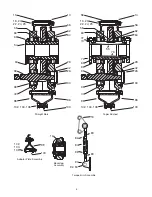
1
WARNING: Because of the possible danger to person(s) or
property from accidents which may result from the improper
use of products, it is important that correct procedures be
followed. Products must be used in accordance with the
engineering information specified in the catalog. Proper
installation, maintenance and operation procedures must
be observed. The instructions in the instruction manuals
must be followed. Inspections should be made as necessary
to assure safe operation under prevailing conditions. Proper
guards and other suitable safety devices or procedures as
may be desirable or as may be specified in safety codes
should be provided, and are neither provided by ABB nor
are the responsibility of ABB. This unit and its associated
equipment must be installed, adjusted and maintained by
qualified personnel who are familiar with the construction
and operation of all equipment in the system and the
potential hazards involved. When risk to persons or property
may be involved, a holding device must be an integral part
of the driven equipment beyond the speed reducer output
shaft.
WARNING: To ensure the drive is not unexpectedly
started, turn off and lock-out or tag power source before
proceeding. Failure to observe these precautions could
result in bodily injury.
WARNING: All products over 25 kg (55 lbs) are noted on the
shipping package. Proper lifting practices are required for
these products.
Instruction Manual for Dodge
®
Torque-Arm
™
Speed Reducers
Straight Bore & Taper Bushed
Sizes:
TXT105
TXT205
These instructions must be read thoroughly before installation or operation. This instruction manual was accurate at the time of
printing. Please see
baldor.com
for updated instruction manuals.
Note! The manufacturer of these products, Baldor Electric Company, became ABB Motors and Mechanical Inc. on
March 1, 2018. Nameplates, Declaration of Conformity and other collateral material may contain the company name of
Baldor Electric Company and the brand names of Baldor-Dodge and Baldor-Reliance until such time as all materials have
been updated to reflect our new corporate identity.
INSTALLATION:
1. Use eyebolt to lift reducer.
2. Determine the running position of the reducer. (See Fig. 1)
Note that the reducer is supplied with either 4 or 7 plugs;
4 around the sides for horizontal installations and 1 on
each face for vertical installations. These plugs must be
arranged relative to the running positions as follows:
Horizontal Installations:
Install the magnetic drain plug
in the hole closest to the bottom of the reducer. Throwaway
the tape that covers the filler/ventilation plug in shipment
and install plug in topmost hole. Of the 3 remaining plugs
on the sides of the reducer, the lowest one is the minimum
oil level plug.
HORIZONAL APPLICATIONS
VERTICAL MOUNT
Position A
Position B
Position C
Position D
Position E
Position F
B = Breather
D = Drain
L = Level
P = Plug
Figure 1 - Mounting Positions
Vertical Installations:
Install the filler/ventilation plug in
the hole provided in the top face of the reducer housing.
Use the hole in the bottom face for the magnetic drain plug.
Of the 5 remaining holes on the sides of the reducer, use
a plug in the upper housing half for the minimum oil level
plug.
3. The running position of the reducer in a horizontal
application is not limited to the four positions shown in
Figure 1. However, if running position is over 20’ either way
from position “B” or “D” in Fig. 1 sketches, or 5’ either way
from position “A” or “C,” the oil level plug cannot be safely
used to check the oil level, unless during the checking the
torque arm is disconnected and the reducer is swung to
within 20’/5° of the positions shown in Figure 1. Because
of the many possible positions of the reducer, it may be
necessary or desirable to make special adaptations using
the lubrication fitting holes furnished along with other
standard pipe fittings, stand pipes and oil level gages as
required. 3.


























